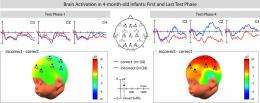Italian for beginners: Four-month-olds can detect grammatical rules in new language

(PhysOrg.com) -- Infants are able to learn grammatical regularities in a novel language surprisingly early and at a remarkable speed. In a study at the Max Planck Institute for Human Cognitive and Brain Sciences in Leipzig, researchers working with Angela Friederici showed that the brains of babies were able to learn grammatical relationships between sentence elements in less than 15 minutes and reacted to errors that broke these rules. This was investigated by playing recordings of sentences in Italian to four month old German babies and taking EEG measurements. (Plos One, 22. 03. 2011)
The speed with which children learn languages amazes both parents and researchers. They very quickly learn new words and recognise grammatical rules which link these words in a sentence. It is a well-known fact that very young children can recognise the relationships between adjacent syllables when these frequently appear together.
Grammatical rules, in contrast, often apply to elements that are separated in a sentence. Until now, it was thought that comprehension of these rules develops at approximately 18 months of age. “That seemed to be very late,” says Angela Freiderici, Director of the Department of Neuropsychology at the Max Planck Institute for Human Cognitive and Brain Sciences. In order to test the ability of very young children to learn such rules, Friederici and her colleagues presented sentences in a foreign language – in this case, Italian – to four month old German infants.
The sentences were specially adapted and had two grammatical constructions. One used the auxiliary verb “può” (can) and a verb with the infinitive ending “-are”, as in the sentence “Il fratello può cantare” (the brother can sing); the other contained a gerund. This was constructed with the auxiliary “sta” (is) and a verb with the ending “-ando”, as in, for example, “La sorella sta cantando” (the sister is singing).
The infants heard correct sentences constructed using these two structures in learning phases that were approximately three minutes long, followed by a short test phase. In this test phase, correct and incorrect sentences were randomly played. Incorrect sentences included an error as in “Il fratello sta cantare” (the brother is sing) or “La sorella può cantando” (the sister can singing). This was repeated four times. EEG measurements of brain activity showed that the children had learned that “può” and “-are” and “sta” and “-ando” belong together. While the processing of correct and incorrect sentences initially resulted in highly similar EEG patterns, in the fourth test phase – after a learning period of less than 15 minutes – very different activation patterns emerged.
“Naturally, at this age, infants do not notice content-related errors,” says Friederici. “Long before they comprehend meaning, babies recognize and generalize regularities from the sound of language.” The brain apparently filters out grammatical relationships from sentences it hears, and is capable of recognizing irregularities in these patterns it has learned within a very short time.
These early processes of extracting regularities from the input are an important element for later language acquisition. Interestingly, early language acquisition differs significantly from the way in which adults learn a foreign language. Adult learners rather seem to focus more on semantic relationships, that is, on the meaning of sentences.
More information: Angela D. Friederici, et al. Precursors to natural grammar learning: Preliminary evidence from 4-month-old infants. PlosOne, 22. 03. 2011














